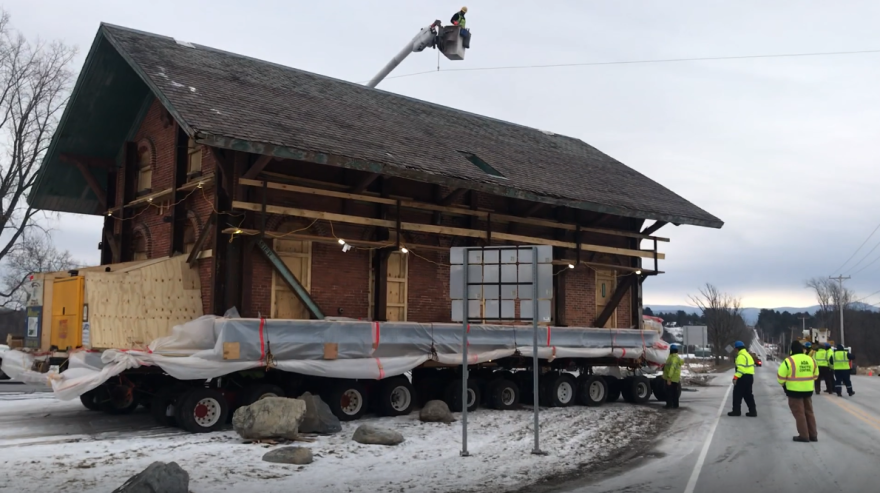Earlier this week, an old brick train station rolled down Route 17 in New Haven, Vt. It was moved to make way for new Amtrak service from Rutland to Burlington, slated to begin later this year.
Amid frigid temperatures Wednesday morning, Colchester resident Jim Jones stood at the edge of the Jiffy Mart parking lot at the corner of Routes 17 and 7 looking at a red brick train station hoisted onto steel beams and a hydraulic wheel system. Before dawn, it was moved to this spot from its original home next to the nearby train tracks. Jones watched as workers prepared to roll it down the highway.
“It's going to go out into a farmer's field and then it'll find its way into New Haven village. So about a mile-and-a-half journey overall,” Jones said.
This station, over 20 feet tall with ornate curved windows, was built in 1868, according to Jones. And he should know. He literally wrote the book on it, called New Haven Junction to Bristol Vermont: Crossroads to Caskets.
“The caskets part is the fact that that little six mile railroad from Bristol to New Haven Junction, and then on to the Rutland railroad, carried more caskets than any other railroad in the northeastern United States,” Jones said. “Because in Bristol, they had the Bristol Manufacturing Company, which made caskets.”

Besides caskets, other kinds of freight — and passengers — came through the New Haven station for nearly 100 years. Then, in 1961, the railroad shut down, and the station with it, Jones said. The state took over the building, and it saw some wear and tear.
“The building was abandoned for a number of years. It was boarded up; it had been run into by a truck; a train had derailed in front of it and compromised the structure,” Jones said.
Eventually, the state Division for Historic Preservation took ownership of the building, intending for it to be a transportation museum.
“But because it had been hit and it was too close to the railroad and an intersection, it was determined that it was best to use it for commercial purposes,” said State Historic Preservation Officer Laura Trieschmann.
The state ended up leasing the station to a local construction company.
Then, as a long-awaited plan to bring Amtrak service along the tracks came to fruition, the state was told the station was a safety hazard, and would have to move or get demolished.
More from VPR: 'Did It Work?' Bringing Amtrak Train Service From Rutland To Burlington
“Demolition was really not something that anybody at the state was willing to contemplate,” Trieschmann said.
Why not? Because Vermont understands “the importance of visual landmarks, of community landmarks like this,” she said.
“Demolition was really not something that anybody at the state was willing to contemplate” - Laura Trieschmann, State Historic Preservation Officer
Moving the building clears another obstacle to bringing Amtrak service up the western side of Vermont, a dream decades in the making. But preserving it comes at a steep cost: close to $1 million. The state chipped in $400,000 last year, and a federal grant added another $350,000. But as a state transportation official told House lawmakers this month, the town needs at least another $200,000 just to put the station on a new foundation, money it hasn’t yet secured. Until then, the station will temporarily reside next to the New Haven town offices.
Those on hand to watch the building roll down the road said it’s a worthy effort.
“It’s a historical building,” said John Lincoln of Middlebury, who was at the site along with his co-worker Alexis Walker of Rutland, working for a traffic control company. While they’re both glad the building is being preserved, they said it’ll be different to have it gone from near Route 7.
“For me, when I drive by, it’s how I know I’m halfway to Burlington or something,” Walker said. “So, it’s going to be different not seeing it there anymore.”
“The geese come down every year to have their hatchlings,” Lincoln noted, referring to snow geese that stop through this area on their migration route. “This is a landmark for them to look for. What’s going to happen?”
Suddenly, as Lincoln considered the fate of the snow geese and his excitement to ride the new Amtrak line, the station began to move.
Powered by a diesel engine, the wheels under the structure started to turn, and it moved — slowly — onto Route 17. Its next stop is a frozen farm field. Then, in the coming week, the plan is to maneuver it under two sets of power lines, and make it to its temporary home in New Haven… eventually.
“They say it moves 3 miles per hour, top speed,” Walker remarked. “It’s going to take a long time to get where it’s got to go.”
Have questions, comments or tips?Send us a message or get in touch with reporter Henry Epp@TheHenryEpp.
We've closed our comments. Read about ways toget in touch here.




